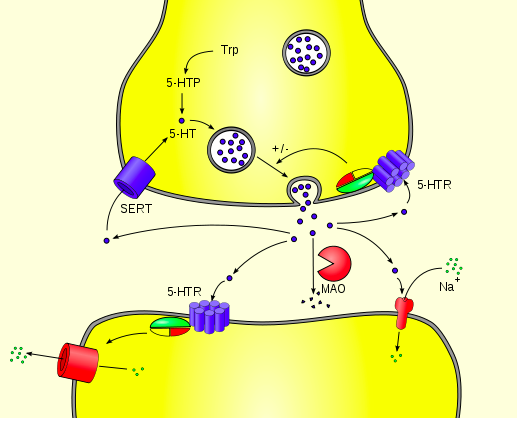Depression
Nature vs. Nurture and Depression
Genetic studies give us clues as to why some are more vulnerable to depression.
Posted July 29, 2017
Back in 2003, Avshalom Caspi published a paper in Science that rocked everyone's world (at least in psychiatry): Influence of Life Stress on Depression: Moderation by a Polymorphism in the 5-HTT Gene.
I know that doesn't sound that exciting, but this paper manages to link nature, nurture, and depression in one elegant demonstration, and it was later replicated.* It was one of the earliest genetic clues as to the possible causes of depressive disorders.
Caspi used subjects from a lifelong observational study of Caucasian New Zealanders known as the Dunedin Multidisciplinary Health and Development Study. This cohort of 1037 children was studied at ages 3, 5, 7, 9, 11, 13, 15, 18, and 21, and 96% of the subjects could still be found to answer questions at the age of 26. This careful observation and follow-up meant that Caspi could rely not only on the memories of the subjects about history of trauma and medical/depressive issues (which can be to some extent unreliable), but also what was studied and written down at all the data points in the subject's lives.
847 members of the cohort were divided into three groups based on 5-HTTLPR genotype. For 5-HTTLPR those genotypes are determined by how long the segment of the gene is. One allele of this gene has a segment that repeats 12 times and the other the same segment repeats 14 times. Thus they are known as the short and long alleles of the gene, respectively. Since we get one gene from each parent, that means that humans are subdivided into three types based on this gene: SS, LL, and SL. In Caucasian populations, about 20% are SS, 30% are LL, and 50% are SL. African populations have a much lower percentage of SS (only about 4%) and Asian populations much higher SS, nearly 70%. Research in depression and stress with respect to this gene varies based on race, so the populations studied are important to keep in mind.
But what does the 5-HTTLPR gene have to do with depression, at least in this New Zealand population? This gene is the promoter region for the serotonin transporter, which means this gene determines how many serotonin transporters you have. Serotonin is an important neurotransmitter in regulating our emotional state. Like any neurotransmitter, serotonin is made by one neuron, which then spits it out into the synapse in between neurons. Then the serotonin floats over to the second neuron and activates the receptors over there. On the first neuron, there is a serotonin reuptake transporter that sucks serotonin back into the first neuron to be recycled and used again. See the picture below:

The little purple dots are serotonin, made in the top cell, then pushed out into the space between the cells to act on the serotonin receptors (5-HTR). The purple cylinder labeled "SERT" is the re-uptake transporter that recycles serotonin so it can be used again. This also happens to be the main spot where the most famous antidepressants, SSRIs, such as Prozac, work. People with the SS genotype of the 5-HTTLPR make fewer transporters than those with the LL, and LS folks are somewhere in the middle.
People and other primates who have two long copies of the gene (the LL)** have more serotonin in the spinal fluid while people with the SS have less. There are all sorts of interesting implications of this genetic difference that have been studied since, and I'll follow up on those in subsequent posts, but for now we will focus on the original findings. Serotonin-speaking, SS is the short end of the stick, SL is in the middle, and LL is protective. SS and LL genotypes may have different advantages and disadvantages, since both are pretty common.
Back to New Zealand, where it was found that 17% of the young adults in the Dunedin cohort were SS, 51% were SL, and 31% were LL...basically the Caucasian frequencies that have held when studying later populations. Caspi and his crew collected information about previous depressive episodes, suicide attempts, previous traumatic events (employment, financial, housing, health, and relationship stressors), and current psychological state. It turns out that when you look at current or previous depression or suicide attempts, the link between the type of promoter you have and those findings are non-significant. Uh oh. That sounds like a big bust! The type of serotonin transporter gene promoter you have doesn't seem to matter…
Then Caspi's team ran the numbers backwards and forwards, and associated reports and amount of abuse in childhood to generate this remarkable finding:

As you can see, with no abuse, the SS, LL, and SL genotypes all have a similar lifetime risk of developing depression. Once you add childhood abuse, though, the LL genotype still has about the same risk as with no abuse, while the SL and SS risk climbs dramatically. With severe childhood maltreatment as a variable, the SS folks have a 63% chance of having a major depressive episode by age 26. The LL severely maltreated children had a 30% risk of having a major depressive episode by age 26. In the Dunedin study cohort, SS folks with 4 or more stressful life events accounted for only 10% of the study population, but 23% of the cases of diagnosed depression.
So what we have found here is that this particular genetic lottery can tell us to some extent which of us are more resilient to stress, and which of us are less so, at least with respect to depressive episodes. These genes are things we cannot change, but learning the pathology of why the S genotype makes us more vulnerable depression in certain contexts can help us both treat and prevent depression. Scientists have been looking at this for the last 15 years, and there's more to come in the next post.
*There was a back and forth about the replication of this study, but a large analysis in JAMA Archives in 2011 held to the original findings and found significant problems with earlier studies that did not replicate.
**There are also rarer mutations in the long gene that make it the functional equivalent of a short gene that have been discovered since the original Caspi paper came out.
Copyright Emily Deans MD




